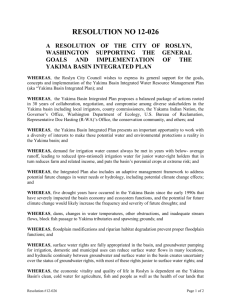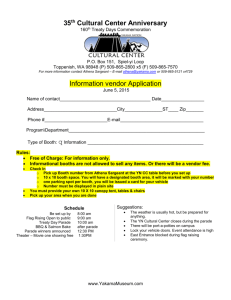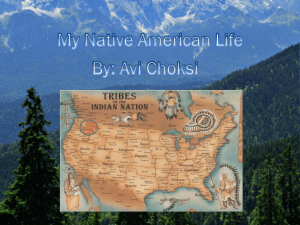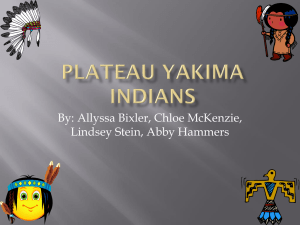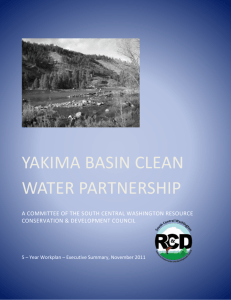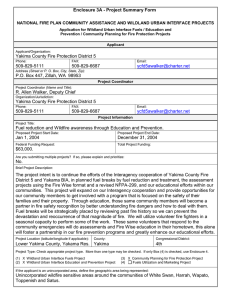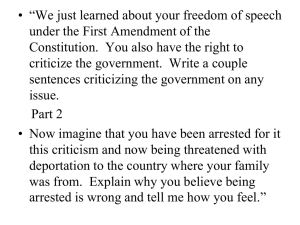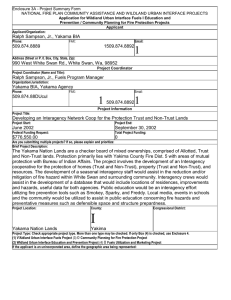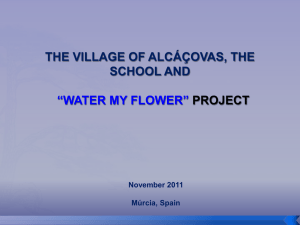watwa m 21 vyvyyan - Law Seminars International
advertisement
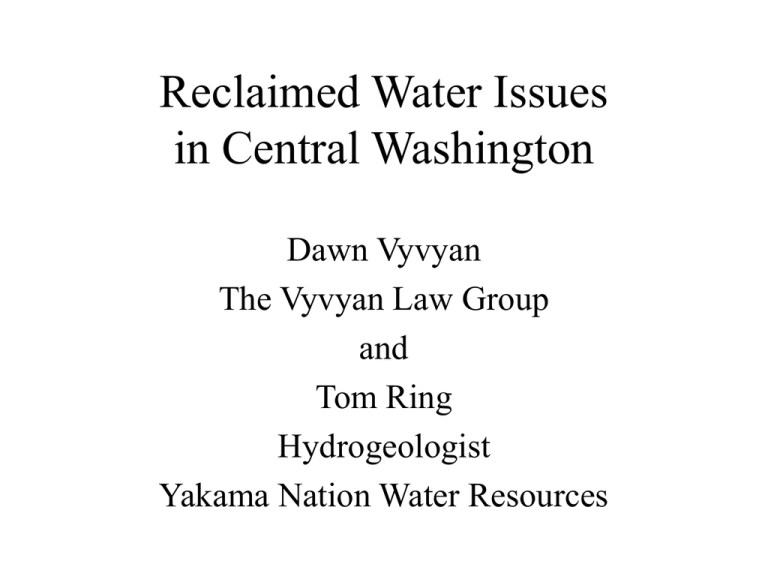
Reclaimed Water Issues in Central Washington Dawn Vyvyan The Vyvyan Law Group and Tom Ring Hydrogeologist Yakama Nation Water Resources Tell ‘em what you’re not gonna tell ‘em • Not going to offer legal opinions • Not going to offer YN Policy Positions • Not going to offer state-law definition of impairment • Not going to bind YN • Not going to tell you that state law applies to YN Treaty Rights Tell ‘em what you are gonna tell ‘em • In the Yakima basin, we are already reclaiming effluent (after discharged) for out of stream and instream economic uses • Where discharge to saltwater, no problem, other places reclaimed water not new supply • In other Yakama Ceded area watersheds, putting reclaimed water to new consumptive uses may drop flow below minimums Yakama Nation aboriginal territories …the atmosphere they breathed… • The right to resort to the fishing places in controversy was a part of larger rights possessed by the Indians, upon the exercise of which there was not a shadow of impediment, and which were not much less necessary to the existence of the Indians than the atmosphere they breathed. – Justice Joseph Mckenna – U.S. Supreme Court – In United States v. Winans, 1905 U.S. v. Winans, 1905 • Confirmed that the Treaty language assured the right to take fish and all usual and accustomed fishing grounds. • It is an aboriginal right – Indigenous and existing from the earliest known time • Has a Time Immemorial date of priority Winters v. U.S., 1908 • “Winters” water right came after Winans. • Winters confirmed the tribe’s reservation of sufficient water to accomplish the purpose of the Treaty and has a priority date of the creation of the Reservation (1855 for Yakama Nation). • Includes irrigation water for reservation and wildlife and stockwater. • None of the these Yakama Nation surface water rights subject to state law or regulation Article 3 of Treaty of 1855 Article 3 of Treaty of 1855:The exclusive right of taking fish in all the streams, where running through or bordering said reservation, is further secured to said confederated tribes and bands of Indians, as also the right of taking fish at all usual and accustomed places, in common with the citizens of the Territory, and of erecting temporary buildings for curing them; together with the privilege of hunting, gathering roots and berries, and pasturing their horses and cattle upon open and unclaimed land. Supremacy Clause Kittitas Reclamation District v. Sunnyside Valley Irrigation District • Aka Quackenbush decision, 1985 • Same court as 1945 Consent Decree re: irrigation rights in Yakima basin. • 1979: Fish biologist (only one in basin?) observed dewatering of salmon redds. • YN took USBR to federal court over its Treaty fishing rights and won. • 9th Circuit affirmed District Court order to USBR to release reservoir water to protect redds. – Protects Chinook salmon that spawn in fall when streamflows nearest lowest levels – Ensures that in a natural system, spawing site will remain covered with water throughout the year. Quackenbush (cont) • Quackenbush created SOAC, System Operations Advisory Committee, four biologists who recommend flows necessary to maintain fish and other aquatic life • Per Acquavella Court flows reserved under YN Treaty right determined by USBR in consulation with SOAC and others. Flip Flop Upper Mainstem reservoir releases ramp down to shrink river before spawning begins Naches Arm reservoir releases ramp up to make up the difference Yakima River Basin Rainshadow Orographic Uplift and Rainshadow Effect Key Locations in Yakima Basin Reservoirs KRD Diversion Diversions Bumping Roza Diversion Rimrock WIP Diversion Yakama Reservation Sunnyside Diversion ^ Parker Gage The Bucket as Funnel • Think of the Yakima basin as a funnel tapering to the Parker Gage. • After storage control, all flow tapers to the control point at Parker Gage • Reduce any inflow and reservoir releases will be made to maintain diversions and Parker flow • Releases come at expense of TWSA – Result in prorationing or reduced carryover Upstream Impairment • Deliveries to proratable irrigators are reduced to an equal % of “entitlement” • Prorationing based on Total Water SupplyAvailable • Prorationing is without regard to location (above Parker) • Ergo, reduction in input will result in impairment equally to upstream or downstream users Now Reclaim (or just claim) some water • E.g. Yakima discharges about 20cfs at Wastewater Treatment Plant in Gap to Gap reach (above Parker) • That water irrigates ca. 1000 acres and generates ca. $2M (apple anyone?) and sustains streamflow • “Reclaim it and TWSA drops – Prorationing drops in drought years (or does it?) • Burden shared equally among proratables (or is it?) – Can’t impair YN Treaty Rights – Yakima basin “federalized” Yes, Yes Entiat Why Go There? • In Yakima basin, any additional consumptive use will reduce supply for existing instream and out of stream water rights • It’s the water budget… – Old, new, borrowed, blue • We are actually doing pretty well in the Yakima. Don’t need new destabilizing laws that create inevitable conflict.
